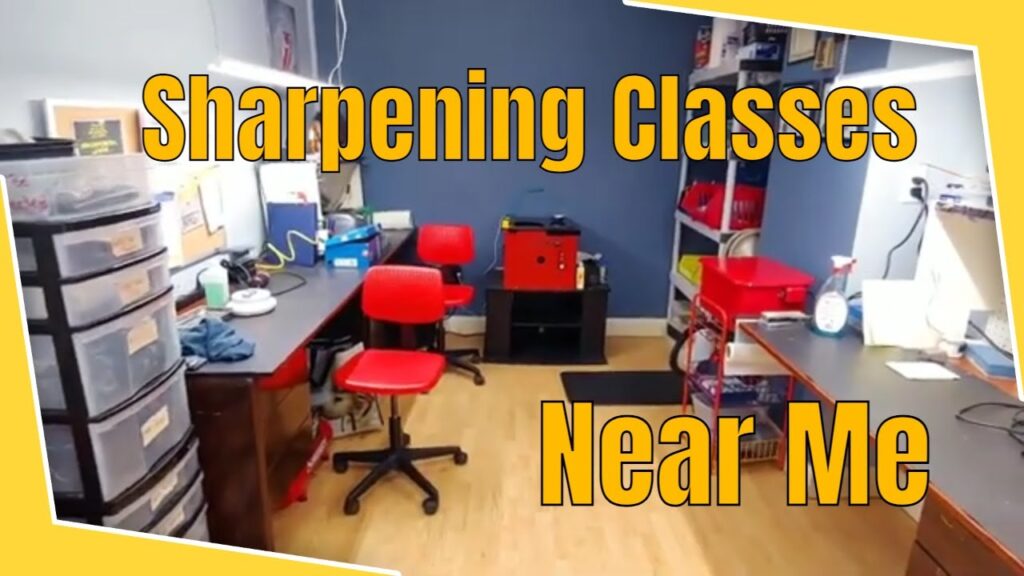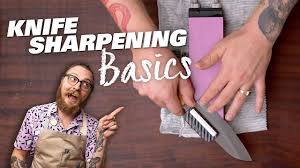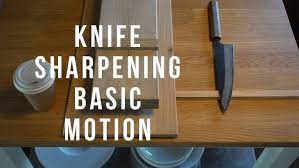introduction
Sure, here’s a suggested introduction for a knife sharpening course offered by Pear Me:
Welcome to Pear Me’s Knife Sharpening Course!
Knife Sharpening Couse Pear Me:- Are you tired of struggling with dull knives that make food preparation more of a chore than a joy? At Pear Me, we believe that every kitchen deserves the precision and ease that comes with properly sharpened knives.
Our Knife Sharpening Course is designed to transform your culinary experience by teaching you the art and science of maintaining razor-sharp blades.[Knife Sharpening Couse Pear Me]

In this course, you’ll learn:
- The Basics of Knife Maintenance: Understand the essential tools and techniques needed to keep your knives in top condition.
- Sharpening Techniques: Discover various methods for sharpening, including honing, whetting, and using sharpening stones.
- Safety Practices: Learn how to handle knives safely and efficiently to avoid accidents and ensure optimal results.
- Practical Tips: Get insights into common sharpening mistakes and how to correct them.
Whether you’re a home cook eager to elevate your kitchen skills or a professional looking to refine your technique, our course offers hands-on experience and expert guidance to help you achieve the perfect edge. Join us and unlock the secrets to a sharper, safer, and more enjoyable cooking experience![Knife Sharpening Couse Pear Me]
https://financemitra.in/two-chicks-with-a-side-hustle-blog/
Feel free to adjust the details to better fit your course specifics or audience.

what is Knife Sharpening Couse Pear Me:-
It sounds like “Knife Sharpening Couse Pear Me” might be a typo or miscommunication. If you meant “Knife Sharpening Course Pear Me,” it would imply a knife sharpening course offered by or associated with a company or entity named “Pear Me.”[Knife Sharpening Couse Pear Me]
If you’re asking about the concept or content of such a course, it would typically include:
- Introduction to Knife Sharpening: Understanding why knife sharpening is important for both safety and efficiency in the kitchen.
- Types of Sharpening Tools: Learning about different tools used for sharpening knives, such as sharpening stones, honing rods, and electric sharpeners.
- Techniques and Methods: Gaining hands-on experience with various sharpening techniques, including honing, grinding, and stropping.
- Knife Maintenance: Tips on how to properly care for and maintain your knives to ensure they remain sharp and functional for a long time.
- Safety Practices: Emphasis on safe handling of knives and sharpening tools to avoid accidents and injuries.
- Practical Application: Applying the sharpening techniques to different types of knives, from chef’s knives to paring knives.
If “Pear Me” is a specific organization or company, it would be helpful to refer to their website or contact them directly for detailed information about their knife sharpening course.[Knife Sharpening Couse Pear Me]
It seems like you’re asking about how a knife sharpening course offered by “Pear Me” works. I’ll outline a general structure for how such a course might function, based on typical offerings in the industry. If “Pear Me” is a specific organization or entity, their course might have unique elements, but here’s a general overview:[Knife Sharpening Couse Pear Me]

How the Knife Sharpening Course at Pear Me Works
- Enrollment and Access:
- Sign-Up: Register for the course through Pear Me’s website or physical location. You may need to choose between different formats such as in-person classes, online modules, or a hybrid approach.
- Materials: Once enrolled, you might receive a list of required materials or tools, which could include knives, sharpening stones, honing rods, and safety gear.[Knife Sharpening Couse Pear Me]
- Course Structure:
- Introduction: Start with an overview of the course objectives, including the importance of knife sharpening and how it enhances safety and efficiency in the kitchen.
- Theoretical Sessions: Learn about the different types of knives and sharpening tools, as well as the science behind knife edges and cutting performance.
- Practical Workshops: Engage in hands-on practice where you’ll apply sharpening techniques using various tools. This might include:
- Honing: Using a honing rod to realign the knife edge.
- Sharpening Stones: Techniques for using whetstones to sharpen the blade.
- Electric Sharpeners: How to use electric devices for convenience.
- Knife Maintenance: Discover methods for maintaining sharp edges and keeping your knives in optimal condition.
https://financemitra.in/how-to-start-an-ice-machine-business/
- Safety and Techniques:
- Safety Protocols: Learn about safe handling of knives and sharpening tools to prevent accidents.
- Skill Development: Develop your skills through guided practice, focusing on precision, consistency, and technique.
- Assessment and Feedback:
- Evaluation: Some courses may include assessments or practical tests to gauge your sharpening skills.
- Feedback: Receive constructive feedback from instructors to improve your technique and address any challenges.
- Completion and Certification:
- Completion: After successfully finishing the course, you may receive a certificate or acknowledgment of your skills.
- Ongoing Support: Some courses offer continued support or additional resources for further learning and practice.
- Application:
- Real-World Use: Apply what you’ve learned in your daily cooking routines, whether at home or in a professional setting.[Knife Sharpening Couse Pear Me]
Additional Considerations
- Customization: Depending on the course, there might be options for customizing the curriculum based on your skill level and specific needs.
- Resources: Access to instructional materials, videos, or online forums for additional help and tips.[Knife Sharpening Couse Pear Me]
For the most accurate details, including specific course offerings, schedules, and costs, you should reach out directly to Pear Me or visit their official website.
When considering the essential points of a knife sharpening course like the one potentially offered by Pear Me, here are some key aspects to focus on:[Knife Sharpening Couse Pear Me]

Important Points of a Knife Sharpening Course
- Course Overview:
- Purpose: Understand the objective of the course, which is to teach proper knife sharpening techniques and maintenance for improved performance and safety in the kitchen.
- Types of Knives:
- Knife Varieties: Learn about different types of knives (e.g., chef’s knives, paring knives, serrated knives) and how each requires specific sharpening techniques.[Knife Sharpening Couse Pear Me]
- Sharpening Tools and Equipment:
- Sharpening Stones: Techniques for using whetstones or sharpening stones, including the correct angles and strokes.
- Honing Rods: How to use honing rods to maintain the edge between sharpenings.
- Electric Sharpeners: Operation and maintenance of electric sharpening devices.
- Strops: Use of leather strops or other materials for fine-tuning the edge.[Knife Sharpening Couse Pear Me]
- Sharpening Techniques:
- Angle Control: Importance of maintaining the correct sharpening angle to achieve the desired edge.
- Technique Variations: Different methods for sharpening, such as the “push” and “pull” techniques, and how to choose the right method for each type of knife.
- Knife Maintenance:
- Edge Preservation: Tips for maintaining a sharp edge and prolonging the life of your knives.
- Cleaning and Storage: Proper cleaning techniques and safe storage methods to avoid damage.
- Safety Practices:
- Handling Knives: Best practices for safely handling and sharpening knives to prevent accidents.[Knife Sharpening Couse Pear Me]
- Tool Safety: Guidelines for safely using sharpening tools and equipment.
- Practical Experience:
- Hands-On Practice: Opportunities to apply sharpening techniques under the guidance of an instructor, including working on various types of knives.
- Problem Solving: Learning how to address common sharpening issues and troubleshoot problems.
- Expert Guidance:
- Instructor Expertise: Access to experienced instructors who can provide personalized feedback and tips.
- Course Materials: Use of instructional materials such as guides, videos, and demonstrations to enhance learning.
- Assessment and Certification:
- Skill Evaluation: Assessment of your sharpening skills through practical tests or evaluations.
- Certification: Possibility of receiving a certificate or acknowledgment upon successful completion of the course.
- Additional Resources:
- Ongoing Support: Availability of resources or support for continued learning and practice after the course.
- Community: Access to forums or groups for connecting with other participants and sharing tips and experiences.[Knife Sharpening Couse Pear Me]
Understanding these key points can help you determine if the course meets your needs and ensure you gain the most from your knife sharpening education. For specific details, including course schedules and registration, contacting Pear Me directly or visiting their website would provide the most accurate information.[Knife Sharpening Couse Pear Me]
If you’re looking for new or updated information about the Knife Sharpening Course from Pear Me, here’s a general approach to finding the latest details:
https://financemitra.in/craigslist-middleman-straegy/

Steps to Find Updated Information
- Visit the Official Website:
- Website: Check Pear Me’s official website for the most recent information on their knife sharpening course. Look for sections like “Courses,” “Workshops,” or “Events” for details on schedules, formats, and content.[Knife Sharpening Couse Pear Me]
- Contact Pear Me Directly:
- Customer Service: Reach out to Pear Me’s customer service or course coordinator via phone or email for the latest updates and specific questions.
- Social Media: Follow Pear Me’s social media profiles for announcements and updates on their knife sharpening course.
- Check Reviews and Testimonials:
- Student Feedback: Look for recent reviews or testimonials from past participants to get insights into the course’s current format and effectiveness.
- Look for News and Press Releases:
- Announcements: Search for any recent news articles or press releases related to Pear Me that might provide information on new course offerings or changes.
- Explore Online Learning Platforms:
- Platforms: If Pear Me offers online courses or has partnered with online education platforms, check those platforms for updated course information and schedules.
- Inquire About Course Content and Formats:
- New Features: Ask about any new features or updates to the course content, such as additional modules, new sharpening techniques, or enhanced instructional materials.
Possible Updates to Look For
- New Course Modules: Introduction of new topics or advanced sharpening techniques not previously covered.
- Enhanced Tools: Updates on the tools and equipment used in the course, possibly incorporating the latest technology or methods.
- Format Changes: Changes in course delivery, such as new online components, hybrid models, or in-person workshops.
- Instructor Updates: Information on any new instructors or experts joining the course, bringing fresh perspectives or specialized knowledge.
- Certification: Updates on certification requirements or new certifications offered upon course completion.
For the most accurate and current information, directly reaching out to Pear Me is your best bet.
Is there money in knife sharpening?
Yes, a knife-sharpening business can be very successful. Your business will thrive if you work hard and provide excellent customer service. You can maximize profits and keep most of your income (if you don’t choose to hire employees) because the ongoing costs are modest.7 Nov 2023
What is the best degree to sharpen a knife?
20 degrees angle
In fact, a 20 degrees angle is often considered the best sharing point for most knives. It is our experience that kitchen knives sharpened to 17 to 20 degrees cut very well and are still durable. For pocket or outdoor knives, a 20 degree angle would be on the low side of ideal.
How to learn knife sharpening?
Steps to Sharpen a Knife
Step 1: Soak Your Stones.
Step 2: Set Up Your Station.
Step 3: Begin First Stroke.
Step 4: Maintain Angle.
Step 5: Finish Stroke and Repeat.
Step 6: Look for Silty Water.
Step 7: Check for Burr.
Step 8: Start Sharpening Second Side.
What is the going rate for knife sharpening?
They will charge an average of $1 to $2 per inch of the blade for each knife; this can differ slightly per retailer and the exact knife type you have, but most of the time, generally, this is what you will be paying as part of the flat rate.
Is it OK to sharpen knife everyday?
You should generally sharpen your knives at least every two weeks, though it depends on how often you use them. Your daily, go-to knives should definitely get a sharpening, but for those that you only use once in a while, that’s up to you.10 Jul 2023

Pingback: Mobile Notary Washing State - FinanceMitra
Pingback: Loan Signing Agent Massachusetts - FinanceMitra
Pingback: How Much Does It Cost To Get Ordained In Arkansas? - FinanceMitra